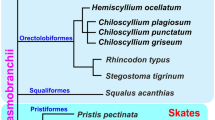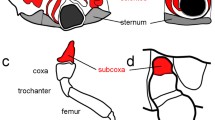Abstract
The hydrolase Notum (also known as Wingful) has been implicated in shaping the distribution gradient of the morphogen Wingless in Drosophila by modifying the Wingless-binding heparan sulfate proteoglycan (HSPG) core glypicans Dally and Dally-like. Here we report on the expression of a Notum homolog during the embryonic development of the spider Cupiennius salei. Notum is expressed in two to three stripes in the posterior region of the germband where new segments are formed. At this location no Wingless expression is present, suggesting that Notum may be involved in the regulation of another HSPG-binding morphogen, possibly Hedgehog. In older segments, however, expression of Notum and Wingless roughly coincides. In the appendages, Notum is expressed in ventral mesodermal cells, directly adjacent to the Wingless expressing ectodermal cells. This could indicate a role for the mesoderm in regulating morphogen gradient formation in the ectoderm.



Similar content being viewed by others
References
Altschul SF, Madden TL, Schaffer AA, Zhang J, Zhang Z, Miller W, Lipman DJ (1997) Gapped BLAST and PSI-BLAST: a new generation of protein database search programs. Nucleic Acids Res 25:3389–3402
Baeg GH, Lin X, Khare N, Baumgartner S, Perrimon N (2001) Heparan sulfate proteoglycans are critical for the organization of the extracellular distribution of Wingless. Development 128:87–94
Binari RC, Staveley BE, Johnson WA, Godavarti R, Sasisekharan R, Manoukian AS (1997) Genetic evidence that heparin-like glycosaminoglycans are involved in Wingless signaling. Development 124:2623–2632
Damen WGM (2002) Parasegmental organization of the spider embryo implies that the parasegment is an evolutionary conserved entity in arthropod embryogenesis. Development 129:1239–1250
Desbordes SC, Sanson B (2003) The glypican Dally-like is required for Hedgehog signalling in the embryonic epidermis of Drosophila. Development 130:6245–6255
Franch-Marro X, Marchand O, Piddini E, Ricardo S, Alexandre C, Vincent JP (2005) Glypicans shunt the Wingless signal between local signalling and further transport. Development 132:659–666
Gerlitz O, Basler K (2002) Wingful, an extracellular feedback inhibitor of Wingless. Genes Dev 16:1055–1059
Giraldez AJ, Copley RR, Cohen SM (2002) HSPG modification by the secreted enzyme Notum shapes the Wingless morphogen gradient. Dev Cell 2:667–676
Gonzalez F, Swales L, Bejsovec A, Skaer H, Martinez Arias A (1991) Secretion and movement of Wingless protein in the epidermis of the Drosophila embryo. Mech Dev 35:43–54
Gonzalez-Gaitan M (2003) Endocytic trafficking during Drosophila development. Mech Dev 120:1265–1282
Han C, Belenkaya TY, Wang B, Lin X (2004) Drosophila glypicans control the cell-to-cell movement of Hedgehog by a dynamin-independent process. Development 131:601–611
Han C, Yan D, Belenkaya TY, Lin X (2005) Drosophila glypicans Dally and Dally-like shape the extracellular Wingless morphogen gradient in the wing disc. Development 132:667–679
Hughes CL, Kaufman TC (2002) Exploring myriapod segmentation: the expression patterns of even-skipped, engrailed, and Wingless in a centipede. Dev Biol 247:47–61
Janssen R, Prpic NM, Damen WGM (2004) Gene expression suggests decoupled dorsal and ventral segmentation in the millipede Glomeris marginata (Myriapoda: Diplopoda). Dev Biol 268:89–104
Kirkpatrick CA, Dimitroff BD, Rawson JM, Selleck SB (2004) Spatial regulation of Wingless morphogen distribution and signaling by Dally-like protein. Dev Cell 7:513–523
Kreuger J, Perez L, Giraldez AJ, Cohen SM (2004) Opposing activities of Dally-like glypican at high and low levels of Wingless morphogen activity. Dev Cell 7:503–512
Kubota K, Goto S, Hayashi S (2003) The role of Wg signaling in the patterning of embryonic leg primordium in Drosophila. Dev Biol 257:117–126
Lin X, Perrimon N (1999) Dally cooperates with Drosophila Frizzled 2 to transduce Wingless signalling. Nature 400:281–284
Nulsen C, Nagy LM (1999) The role of Wingless in the development of multibranched crustacean limbs. Dev Genes Evol 209:340–348
Prpic NM (2004) Homologs of Wingless and decapentaplegic display a complex and dynamic expression profile during appendage development in the millipede Glomeris marginata (Myriapoda: Diplopoda). Front Zool 1:6
Prpic NM, Janssen R, Wigand B, Klingler M, Damen WGM (2003) Gene expression in spider appendages reveals reversal of exd/hth spatial specificity, altered leg gap gene dynamics, and suggests divergent distal morphogen signaling. Dev Biol 264:119–140
Reichsman F, Smith L, Cumberledge S (1996) Glycosaminoglycans can modulate extracellular localization of the Wingless protein and promote signal transduction. J Cell Biol 135:819–827
Siegfried E, Perrimon N (1994) Drosophila Wingless: a paradigm for the function and mechanism of Wnt signaling. Bioessays 16:395–404
Simonnet F, Deutsch J, Queinnec E (2004) Hedgehog is a segment polarity gene in a crustacean and a chelicerate. Dev Genes Evol 214:537–545
Strimmer K, von Haeseler A (1996) Quartet puzzling: a quartet maximum likelihood method for reconstructing tree topologies. Mol Biol Evol 13:964–969
Swofford DL (2002) PAUP*. Phylogenetic analysis using parsimony (* and other methods), version 4. Sinauer Associates, Sunderland, MA
The I, Bellaiche Y, Perrimon N (1999) Hedgehog movement is regulated through tout-velou-dependent synthesis of a heparan sulfate proteoglycan. Mol Cell 4:633–639
Tsuda M, Kamimura K, Nakato H, Archer M, Staatz W, Fox B, Humphrey M, Olson S, Futch T, Kaluza V, Siegfried E, Stam L, Selleck SB (1999) The cell-surface proteoglycan Dally regulates Wingless signalling in Drosophila. Nature 400:276–280
van den Heuvel M, Nusse R, Johnston P, Lawrence P (1989) Distribution of the Wingless gene product in Drosophila embryos: a protein involved in cell–cell communication. Cell 59:739–749
Acknowledgements
We thank Diethard Tautz for his encouragement and support. We also thank Andrew Economou (UCL) for English language editing. The work of WD was supported in part by the Deutsche Forschungsgemeinschaft through SFB 572 of the Universität zu Köln. NMP was supported by a grant from the Deutsche Forschungsgemeinschaft (Grant TA99/19-2). The experiments described in this study comply with the current laws of the country in which they were performed (Germany)
Author information
Authors and Affiliations
Corresponding author
Rights and permissions
About this article
Cite this article
Prpic, NM., Damen, W.G.M. A homolog of the hydrolase Notum is expressed during segmentation and appendage formation in the Central American hunting spider Cupiennius salei. Naturwissenschaften 92, 246–249 (2005). https://doi.org/10.1007/s00114-005-0617-1
Received:
Accepted:
Published:
Issue Date:
DOI: https://doi.org/10.1007/s00114-005-0617-1




